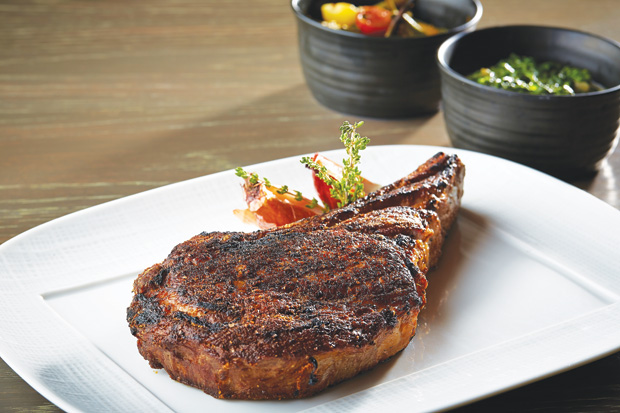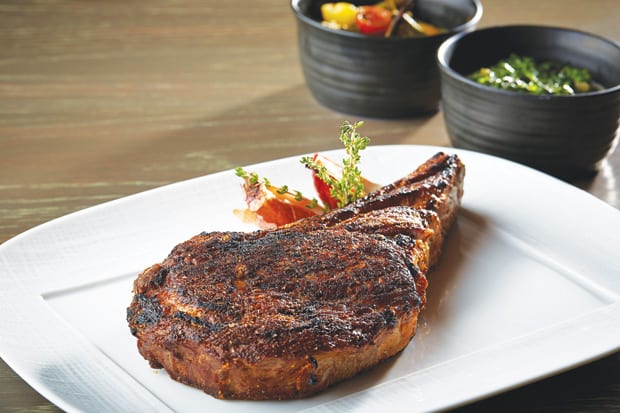Why can’t a steakhouse be a fine-dining experience? Knife proves it can

MEAT MARKET | The 45-day dry-aged ribeye from Niman Ranch has a unique mouthfeel and unparalleled flavor — as well as a deceptively simple preparation.
ARNOLD WAYNE JONES | Executive Editor
When John Tesar first came to Dallas, to take over the kitchen of The Mansion on Turtle Creek where Dean Fearing had ruled for two decades, he was jumping into a shark tank. How do you replace a legend in a foodie town filled with famous chefs?
Fortunately, Tesar came from a seafood background, so he felt right at home with the sharks. He was Rick Moonen’s No. 2 in Las Vegas, but the tradition of
The Mansion required something else: fish, yes, but all sorts of other cuisines. After a newsmaking departure a few years later, he dipped his toe in several different pools: Consulting chef at The Cedars Social, then onto The Commissary, a burger joint in the then-new Arts District. Think of that journey: From fish to peripatetic gastropub to burgers. If nothing else, he demonstrated deftness in a variety of cuisines — not merely a journeyman cook, a “jack-of-all-trades, master-of-none” — but someone who takes on new challenges, a student of the culinary universe.
His next signature restaurant, Spoon — which opened in late 2012 and was one of Dallas Voice’s top 3 new eateries that year — showed what he could do with fine dining when not constrained by the expectations of a prior legend. Again, he delved into fish, compiling a menu of simple yet elegant preparations.
After a Spoon, of course, comes the Knife. The concept opened in Kimpton’s Hotel Palomar in May, but two weeks ago new owners took over and renamed it
The Highland. The renovated Hilton that has anchored the corner of N. Central Expressway across from Mockingbird Station for many decades is remaking itself once again, and Tesar has a hand in it. Once again, he has tried something different; once again, he succeeds.
Knife, like Spoon, is a soup-to-nuts operation. Tesar and his partners conceived it, designed it, renovated it, executed it. Central 214, the long-standing restaurant it replaces, had three high-profile chefs in its 10-year history; Tesar, within his first three months, has probably generated more buzz than they did combined.
Over the course of its lifetime, each chef has brought a different energy to a space that was, sadly, unappealingly banal: High ceilings, a bowling-alley dining room, and cold, reproachful concrete was probably meant to allow the food to speak more than the setting, but all it did was take away one more reason (atmosphere) to eat out. The food could be great, but one wants to feel welcomed, too.
Knife bridges that gap. Gone are the gray, emotionless walls. In their place, warm brushed woods, contrasting grey leather banquettes, and stabs of color and contrasting tones.
Tesar has drawn a better line between bar and restaurant, between hotel and eatery. Although the pub area now lacks its arresting stained glass backdrop, the overall feeling is more social, more buzzy. In the restaurant, it’s the same: Many of the seats are communal; guests sit stranger with stranger, and family-style is the order of the day.
And you’d be a fool not to experience the many levels of dining that Knife offers.
The cocktails (also available in the dining room) are crafty, from classics like Long Island iced tea to new-fangled concoctions. It’s both old and new. And that’s reflected on the menu as well.
Indeed, Knife goes so far as to label its dishes Old School (traditional steakhouse fare) and New School (Tesar’s approachable take on steak).
New School includes all $25 cuts, from the luscious flat-iron to the chewy mouthfeel of the culotte (sirloin cap) cooked viscerally, followed by a sous vide and smoked over red oak. Seasoning — a salt-pepper rub with olive oil, simple but in service to the meat — holds the edge in place as the weeks of dry-ageing in the cabinet of Dr. Caligari work some magic.
Old School is pricier (as is the “Exotic” menu) but amounts to an uncompromising feast and an education. Two items with putatively similar pedigrees — one a 45-day-aged ribeye from Niman Ranch ($80; serves two), one an Akaushi ribeye from Heartbrand ($95; serves two) —seem to be slightly different variations of the same essential product. But just take a bite. The Akaushi — medium rare and purplish, with just a millimeter of char on the outside and tiny veins of fat adding structure — is gamy yet buttery. Then try the Tomahawk cut from Niman: Fatty, darker (this will serve well cooked medium) and rich as Scrooge McDuck. It’s a completely different flavor profile, a completely different texture on the tongue. It’s as if eating an apple pie and a custard pie should be considered equivalent just because they have the word “pie” in common.
What Tesar is trying to accomplish with Knife is a journey, an experience, an appreciation. You can’t be convinced that one of these is better or at least different than the other. Like The Matrix, you simply have to experience it for yourself.
An unmissable appetizer (hidden away under a category called simply Slices; it’s next to one called Slabs) is the “bacon tasting:” Five varieties of cured pig belly that will astonish you by the diversity in what you think is a familiar strip of fat ($12). I had my own favorites: The applewood from Nuekese is awesome, the cob-smoked from New Hampshire subtly winning; but a variety from Tennessee was bland by comparison. It’s worth it to do a horizontal tasting — someone needs to get certification going for “meat sommelier” — to appreciate the variety of meats available here.
Some items you might recognize from prior incarnations. Tesar recycles the decadent fried avocado slices (I call them talons) from his Commissary menu ($10), and his version of steak tartare ($19) (delectable, with a quail egg topping it) is done “in the style” of the New York legend 21. He copies David Chang’s red-eye gravy as well.
But Knife stands on its own. On the margins, there’s much to love, with a pea shoot salad ($15) surprising you with its pea sorbet (who knew?) and a retro Green Goddess dressing. Hand-rolled penne ($24) promises “black truffle essence,” but we enjoyed it much more than the description implied. “Standard” steakhouse sides like mac & cheese ($12) and heirloom carrots ($8) are distinctive. We skipped the creamed spinach — you can only go so far into the old school — as well as the sauces. Who needs sauces on meats like this?
Down to the desserts, service was attentive, knowledgeable and efficient, but not stiff. That’s true of Knife overall.
“We’ve both eaten at fancier restaurants,” my dining companion observed one night, “but I don’t know that I’ve had a better meal.”
That’s what fine dining is about — even if you get it at a steakhouse.
This article appeared in the Dallas Voice print edition August 22, 2014.


